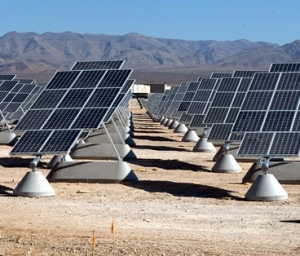Dec 13 2010
Zhengrong Shi, an engineer turned entrepreneur, has become one of China’s richest citizens by betting heavily on the future of solar power. In a talk on Tuesday at MIT, he outlined his vision for how he believes solar energy will, by the end of the century, produce more than two-thirds of the world’s electricity.
Shi grew up in China but spent a decade in Australia pursuing his education and beginning his work in solar cell production. In 2000, he returned to his homeland and began setting up factories to take advantage of China’s low labor costs and other economy measures to produce solar panels at a lower cost than companies elsewhere could match. At the time, China had a negligible presence in the solar business, but now, thanks in large part to Shi’s pioneering work, it dominates the world’s solar industry.
Shi’s company, Suntech, is the clear leader. Except for one year during the economic downturn, the company’s output of solar panels has doubled annually, while production costs and sales prices continue to decline. Already, he said, for many locations (such as Italy) the panels his company produces can generate electricity at “grid parity,” meaning the cost is competitive with that from standard (primarily fossil-fuel) sources. Given present trends, the ever-falling prices should bring other locations, including Hawaii, California and Japan, to grid parity within the next five years, he said.
The incredible shrinking production cost
 The Solar Power Plant located at Nellis Air Force Base in Nevada. Suntech was the largest module supplier for the project.
The Solar Power Plant located at Nellis Air Force Base in Nevada. Suntech was the largest module supplier for the project.
Shi, who has a doctorate in electrical engineering, described several technological approaches that he expects will help to drive up efficiency while lowering costs, including the incorporation of a layer of plasmonic nanostructures — which can help to distribute light so that more of it enters the solar cell and less gets scattered away — bonded onto the front of a silicon solar cell.
That is just one of many technologies being pursued by the company, which invests heavily in research and development and is exploring a variety of approaches to lowering costs, increasing the efficiency of the panels, and incorporating features that drastically lower the time needed for installation, which is a major part of overall system cost for the end users (whether individual homes or utility-scale solar farms).
The company is looking at ways to produce much narrower silver contacts on the solar cells’ front surface, which would increase efficiency by reducing shading (caused by barriers that keep sunlight from striking the surface of the cell). It is also working on “buried contact” cells, where the connections are under the silicon layer so they have no shading, and on ways of making thinner cells to reduce the cost of the silicon needed and the weight of the finished panels.
When Suntech started, the typical price for crystalline silicon solar cells was about $5 per watt, but Shi was able to produce them initially for less than $3. This year, the company has produced about 3 gigawatts’ (GW) worth of solar panels, and Shi said he expects to produce more than 5 GW next year. And thanks to stringent quality control, he said, the company is able to offer a 25-year warranty on the panels’ power output.
But that’s just the beginning, he stressed. “We’re not even a baby yet,” he said; solar technology today is “still an embryo.” For one thing, even as demand keeps growing, “solar is not ready yet” to meet that demand — “we don’t have the scale, we don’t have the supply chain to support” the growth that would otherwise be possible.
As a step toward what he sees as an electric power system that eventually will be dominated by solar, he suggests that hybrid systems — large solar installations paired with conventional fossil-fuel powerplants — could help to bridge the gap, providing steady power by switching to the fossil fuel whenever the sun doesn’t shine or the demand is too large.
Shi’s talk at MIT was sponsored by the MIT China Energy and Environment Research Group, the MIT Energy Initiative and the MIT Energy Club.
Source: http://web.mit.edu/